Dee Finney's blog
start date July 20, 2011
today's date January 2, 2014
page 622
TOPIC: PREVENTING ASTEROIDS FROM HITTING EARTH
NOTE: MULTIPLE METEOROIDS AND METERORITES HAVE BEEN GOING THROUGH EARTH'S ATMOSPHERE RECENTLY. NO REPORTS OF STRIKES TO EARTH, BUT THAT DOESN'T MEAN THAT DUST FROM THESE OBJECTS IS NOT FALLING DOWN UNNOTICED THAT COULD HAVE BACTERIA ON THEM THAT HUMANITY WOULDNT KNOW WHAT TO DEAL WITH IF IT WAS BREATHED IN. THE BIGGER DANGER AT THIS POINT - IS - WITH SO MANY ASTEROIDS GOING AROUND EARTH AT ANY ONE MOMENT, WHERE ARE THEY ALL AND HOW CAN WE PREVENT THEM FROM STRIKING EARTH?
I HAVE PREVIOUSLY WRITTEN ON THIS TOPIC 242 TIMES AND TRACKED ASTEROIDS FOR A THREE YEAR PERIOD RIGHT AFTER OUR DEAR FRIEND KENT STEADMAN SUDDENLY PASSED AWAY IN 2008. WE DECIDED TO RESUME THESE REPORTS IN 2014 BECAUSE THERE IS NEW EFFORT TO TRACKING AND PREVENTING ASTEROIDS FROM STRIKING EARTH WHICH WOULD BE DISASTROUS - MORE SO IF ONE WAS VERY LARGE.
IN 2010, I PUBLISHED THIS LIST:
On January 17, there were 1092 potentially
hazardous asteroids.
On February 17, there were 1100 potentially hazardous asteroids.
NOTE: These are not 'new' asteroids' merely newly discovered by
people and their new telescopes.
On March 24, there were 1110 potentially hazardous asteroids.
On April 5, there are 1110 potentially hazardous asteroids.
On April 14, there are 1117 potentially hazardous asteroids.
On May 15, there are 1127 potentionally
hazardous asteroids.
On June 19, there are 1133 potentially hazardous asteroids.
On June 23, there are 1138 potentially hazardous asteroids.
On July 23, there are 1140 potentially hazardous asteroids.
THIS IS TODAY'S LIST
Potentially Hazardous Asteroids (PHAs) are space rocks larger than approximately 100m that can come closer to Earth than 0.05 AU. None of the known PHAs is on a collision course with our planet, although astronomers are finding new ones all the time.
| Asteroid |
Date(UT)
|
Miss Distance
|
Size
|
| 2011 YD29 |
Dec 28
|
6.1 LD
|
24 m
|
| 2013 YL2 |
Jan 3
|
3.6 LD
|
101 m
|
| 2013 YM48 |
Jan 6
|
8.8 LD
|
34 m
|
| 2007 SJ |
Jan 21
|
18.9 LD
|
1.9 km
|
| 2012 BX34 |
Jan 28
|
9.6 LD
|
13 m
|
| 2006 DP14 |
Feb 10
|
6.2 LD
|
730 m
|
| 2000 EM26 |
Feb 18
|
8.8 LD
|
195 m
|
| 2000 EE14 |
Mar 6
|
64.6 LD
|
1.8 km
|
As you can clearly see, the number of sighted asteroids is growing because more and more amateur astronomers are diligently daily searching the skies over our head all over the earth.
1-7-2014
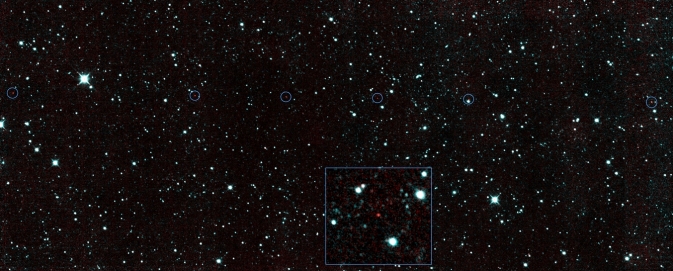
NASA's Near-Earth Object Wide-field Infrared Survey Explorer (NEOWISE) spacecraft has spotted a never-before-seen asteroid -- its first such discovery since coming out of hibernation last year.
NEOWISE originally was called the Wide-field Infrared Survey Explorer (WISE), which had made the most comprehensive survey to date of asteroids and comets. The spacecraft was shut down in 2011 after its primary mission was completed. But in September 2013, it was reactivated, renamed and given a new mission, which is to assist NASA's efforts to identify the population of potentially hazardous near-Earth objects (NEOs). NEOWISE also can assist in characterizing previously detected asteroids that could be considered potential targets for future exploration missions.
NEOWISE's first discovery of its renewed mission came on Dec. 29 -- a near-Earth asteroid designated 2013 YP139. The mission's sophisticated software picked out the moving object against a background of stationary stars. As NEOWISE circled Earth scanning the sky, it observed the asteroid several times over half a day before the object moved beyond its view. Researchers at the University of Arizona used the Spacewatch telescope at the Kitt Peak National Observatory southwest of Tucson to confirm the discovery. Peter Birtwhistle, an amateur astronomer at the Great Shefford Observatory in West Berkshire, England, also contributed follow-up observations. NASA expects 2013 YP139 will be the first of hundreds of asteroid discoveries for NEOWISE.
"We are delighted to get back to finding and characterizing asteroids and comets, especially those that come into Earth’s neighborhood," said Amy Mainzer, the mission's principal investigator from NASA's Jet Propulsion Laboratory (JPL) in Pasadena, Calif. "With our infrared sensors that detect heat, we can learn about their sizes and reflectiveness."
2013 YP139 is about 27 million miles (43 million kilometers) from Earth. Based on its infrared brightness, scientists estimate it to be roughly 0.4 miles (650 meters) in diameter and extremely dark, like a piece of coal. The asteroid circles the sun in an elliptical orbit tilted to the plane of our solar system and is classified as potentially hazardous. It is possible for its orbit to bring it as close as 300,000 miles from Earth, a little more than the distance to the moon. However, it will not come that close within the next century.
WISE discovered more than 34,000 asteroids and characterized 158,000 throughout the solar system during its prime mission in 2010 and early 2011. Its reactivation in September followed 31 months in hibernation.
NEOWISE will continue to detect asteroids and comets. The observations will be automatically sent to the clearinghouse for solar system bodies, the Minor Planet Center in Cambridge, Mass., for comparison against the known catalog of solar system objects and to determine orbit if the object is not known. A community of professional and amateur astronomers will provide follow-up observations, establishing firm orbits for the previously unseen objects. Infrared sensors, similar to the cameras on NEOWISE, are a powerful tool for discovering, cataloging and understanding the asteroid population. Some of the objects about which NEOWISE will be collecting data could become candidates for NASA's announced asteroid initiative, which will be the first mission to identify, capture and relocate an asteroid for astronauts to explore. The initiative represents an unprecedented technological feat that will lead to new scientific discoveries and technological capabilities that will help protect our home planet and achieve the goal of sending humans to an asteroid by 2025.
JPL manages the project for NASA's Science Mission
Directorate in Washington. The Space Dynamics Laboratory in
Logan, Utah, built the science instrument. Ball Aerospace &
Technologies Corp. of Boulder, Colo., built the spacecraft.
Science operations and data processing take place at the
Infrared Processing and Analysis Center at the California
Institute of Technology in Pasadena. Caltech manages JPL for
NASA.
An image of asteroid 2013 YP139, taken by NEOWISE, is
available at:
More information about NEOWISE is available online at:
Dwayne Brown
Headquarters, Washington
202-358-1726
dwayne.c.brown@nasa.gov
DC Agle
Jet Propulsion Laboratory, Pasadena, Calif.
Wikipedia states:
Asteroids are minor planets, especially those of the inner Solar System. The larger ones have also been called planetoids. These terms have historically been applied to any astronomical object orbiting the Sun that did not show the disk of a planet and was not observed to have the characteristics of an active comet, but as minor planets in the outer Solar System were discovered, their volatile-based surfaces were found to resemble comets more closely and so were often distinguished from traditional asteroids. Thus the termasteroid has come increasingly to refer specifically to the small bodies of the inner Solar System out to the orbit of Jupiter. They are grouped with the outer bodies—centaurs, Neptune trojans, and trans-Neptunian objects—as minor planets, which is the term preferred in astronomical circles. In this article the term "asteroid" refers to the minor planets of the inner Solar System.
There are millions of asteroids, many thought to be the shattered remnants of planetesimals, bodies within the young Sun's solar nebula that never grew large enough to become planets. The large majority of known asteroids orbit in the asteroid belt between the orbits of Mars and Jupiter, or are co-orbital with Jupiter (the Jupiter Trojans). However, other orbital families exist with significant populations, including the near-Earth asteroids. Individual asteroids are classified by their characteristic spectra, with the majority falling into three main groups: C-type, S-type, and M-type. These were named after and are generally identified with carbon-rich, stony, and metallic compositions, respectively.
Only one asteroid, 4 Vesta, which has a relatively reflective surface, is normally visible to the naked eye, and this only in very dark skies when it is favorably positioned. Rarely, small asteroids passing close to Earth may be visible to the naked eye for a short time. As of September 2013, the Minor Planet Center had data on more than one million objects in the inner and outer Solar System, of which 625,000 had enough information to be given numbered designations.
HERE IS A NASA GRAPHIC FROM EARLY 2013 OF POTENTIALLY HAZARDOUS ASTEROIDS IN SPACE
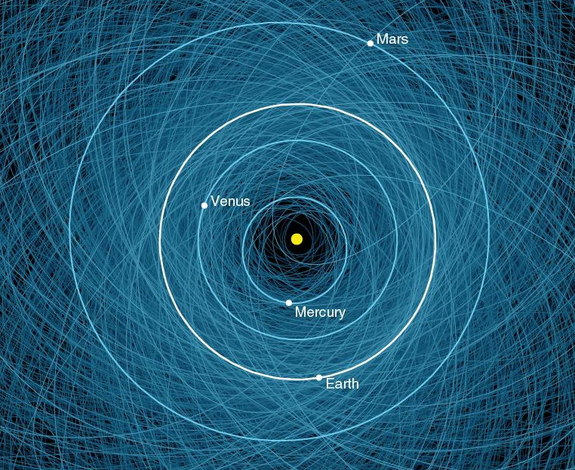
YOU CAN SEE HOW MANY COULD INTERSECT THE ORBIT OF EARTH AT SOME GIVEN POINT.
HERE IS THE ORBIT OF 2013 YL2 WHICH IS CLOSEST TO EARTH ON JANUARY 3, 2014
http://ssd.jpl.nasa.gov/sbdb.cgi?sstr=2013%20YL2&orb=1
THAT IS THE CLOSEST ONE IN THE FIRST QUARTER OF THIS YEAR.
WATCH http://www.spaceweather.com for the daily update of asteroid threats to earth.
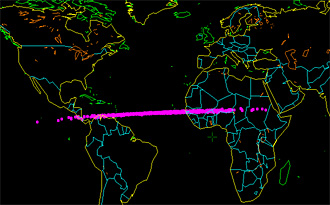
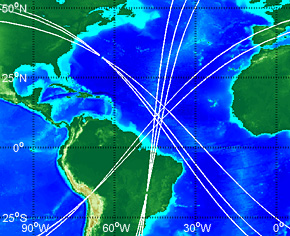
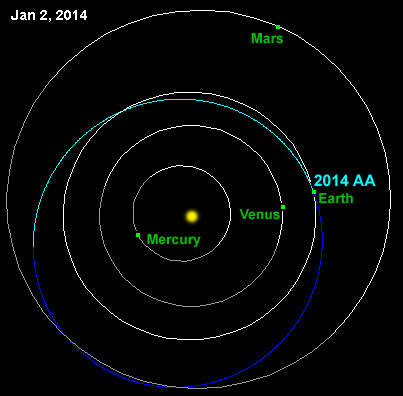
http://ssd.jpl.nasa.gov/sbdb.cgi?sstr=2014%20AA&orb=1
THIS IS WHERE I POST WHAT I'M DOING AND THINKING
BLOG INDEX 2011
BLOG INDEX 2012 - page 1
JANUARY THRU APRIL 2012
MAY THRU AUGUST 2012
SEPTEMBER THRU DECEMBER
BLOG INDEX 2013
BLOG INDEX - PAGE 2 - 2013
BLOG INDEX - PAGE 3 - 2013
BLOG INDEX - PAGE 4 - 2014